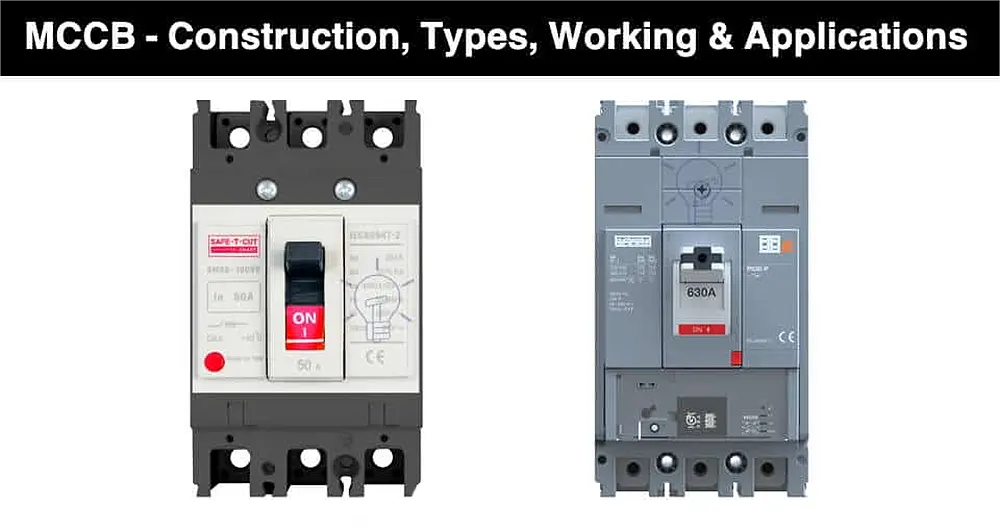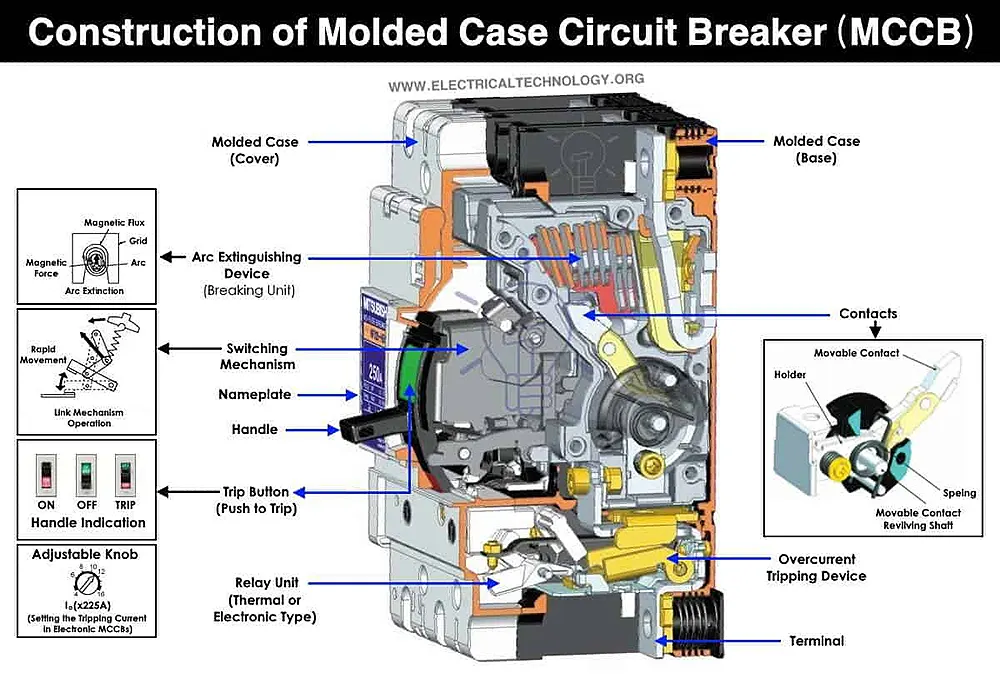Working conditions of molded case circuit breakers
2023-09-18
What is MCCB?
Molded Case Circuit Breaker or MCCB is an automatic electrical device. It is a type of circuit breaker that protects the circuit from overloading, short circuit and current surges. It is an advanced version of miniature circuit breaker MCB since it operates like one. However, it offers extra features that make it a superior circuit breaker such as remote closing and adjustable trip settings i.e. its current settings and time settings can be adjusted according to our needs.

Construction of Molded Case Circuit Breaker
An MCCB is made from the following main parts each one explained in detail
1. Arc chute
2. Contacts
3. Operating mechanism
4. Terminal Connector
5. Thermal Trip Unit
6. Magnetic Trip Unit
7. Handle / Trip-free Mechanism
8. Trip Button

Below is the brief details of each mechanism used in a typical MCCB.
Arc Chute
Arc chute is a set of parallel metal plates that are mutually insulated from each other. it helps in extinguishing the arc by splitting the arc and lengthening it. it is also known as an arc divider or arc splitter. These plates are made of ferromagnetic material.
Contacts
Contacts are the metallic conductors that are responsible for carrying the current to the load. There are two types of contacts i.e. fixed and moving contact. The contacts are made of arc resistance material having low resistivity and corrosion. The quality of the material decides the lifetime of the circuit breaker.
Operating Mechanism
It is the mechanism of MCCB responsible for opening and closing the current-carrying contacts. it is connected with trip unit that triggers the operating mechanism. The trip unit operates on a thermal and magnetic mechanism.
Terminal Connector
The terminal connectors are used to connect the MCCB to the external circuit. The upper terminals are connected to the output/load while the bottom terminals are connected to the input/supply. Although they are bidirectional, the input and output designation is due to their physical installation
Trip Unit
It is the unit responsible to trigger the operating mechanism. The trip unit includes a thermal mechanism for overload, magnetic tripping for short circuits and a test button for testing.
Thermal Trip Unit
The thermal trip unit uses a thermal mechanism that is a bimetallic strip that bends (and opens the contacts) when the temperature rises due to the overloading.
Magnetic Trip Unit
The magnetic trip unit has a relay that generates a magnetic field when higher currents flow through its solenoid due to the short circuit. it trips the circuit breaker. While the test button is used to simulate the above-said mechanisms and test the response of the circuit breaker.
Handle / Trip-free Mechanism
It is a handle used to open or close the breaker manually. It is also known as a trip-free mechanism because it will trip even if the handle is held in ON position.
The handle could be in either three positions i.e. upward, middle or downward. If the handle is in upward position, it is ON position. If it is in the middle position, the breaker has been tripped while the downward position shows OFF status.
Trip Button
The trip button is used for testing the breaker. It is a red-colored button that trips the operating mechanism when pushed.
Working Principle of MCCB
An MCCB protects a circuit from fault current. It uses thermal and magnetic mechanisms to break those fault currents. The thermal mechanism is used for overload protection while the magnetic mechanism is used for short circuit protection
Advantages and Disadvantages of MCCB
Advantages
MCCB has an adjustable trip setting that allows it to be used for low as well as large currents
It can handle a very large current.
It can instantly interrupt very large currents.
It has a movable trip unit.
It has a very small tripping time thus fast switching during fault current.
It also offers a remote ON/OFF feature.
It has a compact design and takes less space.
Disadvantages
MCCB is not suitable for high voltage applications.
They are not suitable for domestic applications.
Applications of MCCBs
Since MCCB can handle very high currents, they are used for heavy-duty applications such as in industries.
Adjustable Trip Settings: MCCB is superior to MCB and has more application due to its higher current handling and adjustable trip setting capabilities. It makes it versatile to be used for high as well as low current settings.



